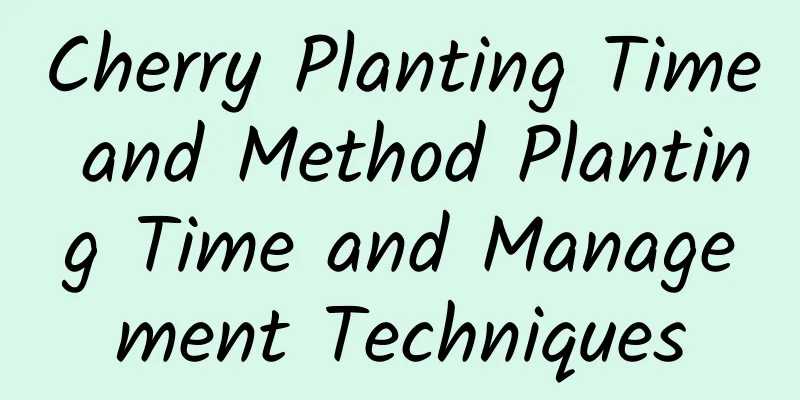Broad bean planting and management methods

|
Broad beans, also known as southern beans, broad beans, and Luohan beans, have large grains, relatively good taste, are rich in protein, have very high nutritional value, and are one of the main economic crops . Below, the editor will introduce the planting and management methods of broad beans. Let’s take a look. 1. Planting time The time for sowing broad beans is mainly concentrated in spring (areas north of the Yangtze River) and autumn (areas south of the Yangtze River). The optimal sowing temperature range is around 18-23 degrees. Generally, the sowing time in the northern region north of the Yangtze River is roughly concentrated around late March to late April, and the sowing time in the northern region north of the Yangtze River is roughly concentrated around mid-October to early November. 2. Planting method When sowing broad beans, you can either sow in rows or spot sowing. The planting density is about 15-20 cm between plants, 25-30 cm between rows, and 6000-7000 seedlings per mu. When sowing, 2-3 seeds can be sown in each hole (thinning out the seedlings in batches after emergence). The sowing depth should be about 4-6 cm, and the sowing amount per mu should be about 6-10 kg. Generally, for varieties with high soil fertility, good water and fertilizer conditions, and many pods and large grains, appropriate sparse sowing and sparse planting will be more conducive to high yields in the later stage. However, for varieties with low soil fertility, poor water and fertilizer conditions, and few pods and small grains, appropriate dense sowing and dense planting will be more conducive to increasing yields in the later stage. 3. Water and fertilizer management Broad beans are drought-resistant but not water-tolerant. They like to grow in moist soil. After the broad beans emerge, they should be watered with running water in time to ensure adequate water supply during the seedling stage. The flowering and podding period is the peak period of water demand for broad beans. It is necessary to pay attention to timely replenishment of water. At the same time, when there is more rain in summer, the fields should be drained in time to avoid waterlogging. Fertilization should be reasonable. Rhizobia will grow at the roots of broad beans, which have a good nitrogen fixation effect. If the base fertilizer is sufficient, there is no need for too much topdressing. During the flowering and podding period of broad beans, a large amount of fertilizer is required. Fertilizer can be added appropriately according to the condition of the seedlings. Potassium dihydrogen phosphate can be sprayed as foliar fertilizer , or compound fertilizer can be applied to the leaves. Special attention should be paid to the addition of phosphorus and potassium fertilizers . 4. Intertillage and weeding The essential purpose of inter-row cultivation and weeding of broad beans is to loosen the soil, eliminate weeds in the field, accelerate the effective exchange of soil nutrients and oxygen, ensure that the broad bean roots can grow in depth, and better grow rhizobia. At the same time, inter-row cultivation and weeding can effectively clean the ditches in the fields, which is beneficial to the irrigation and drainage work in the fields. Generally, during the seedling stage of broad beans, inter-row cultivation and weeding are required 1-2 times, one at the seedling stage and the other at the ridge closing stage. 5. Prevent and control pests and diseases During the growth process, broad beans are easily susceptible to diseases and pests such as aphids and red spot due to changes in the soil, which can cause the broad beans to develop poorly and form fewer nodules. The broad bean plants that grow into them are weak and the yield of broad beans will not be very high. Therefore, after the broad beans are successfully transplanted and planted, the prevention and control of their diseases and pests must be strengthened. The above are the methods of planting and managing broad beans. During the continuous planting of broad beans for many years, the nodules on the roots will secrete a large amount of organic acid, which will reduce the yield and quality of broad beans. Farmers should rotate crops reasonably.
|
<<: What to do if you overwater tomatoes? Symptoms of overwatering
>>: Tomato watering techniques and principles
Recommend
How to manage orchids during the budding period
1. Reduce watering When the orchid sprouts, you c...
When is the best time to sow Paris polyphylla seeds
Sowing time of Paris polyphylla seeds Fritillaria...
What flowers are suitable for growing in Qiqihar, and what are the city flowers and trees?
1. Climate characteristics of Qiqihar Qiqihar has...
How to plant osmanthus and what are the planting time and methods
Osmanthus planting time Osmanthus can generally b...
How to grow blue snow flower
Cultivation method of blue snow flower 1. Soil co...
How to plant the soapberry tree
1. Site selection When planting soapberry trees, ...
What kind of vegetables are suitable for growing in glass greenhouses (What kind of vegetables are suitable for growing in greenhouses)
Glass greenhouse vegetable planting The glass gre...
What kind of soil does the red spider lily like? How many red spider lilies can be planted in one flower pot?
1. What kind of soil do you like? Red spider lily...
Pests of Thunbergia paniculata and their control
Chrysops chinensis The moth can be said to be the...
Where is the best place for ginseng to grow and what temperature environment is suitable
Where do ginseng trees grow? Ginseng tree is suit...
Can the succulent Phoenix be propagated by leaf cuttings? Leaf cutting propagation method
Can the succulent Phoenix be grown by leaf cuttin...
How to grow strawberries in pots
Soil selection When planting strawberries in pots...
Can orchids be grown in coconut coir soil?
Can orchids be grown in coconut coir soil? It is ...
The succulent waterfall in her house hung down two floors in one year, so her neighbors didn’t have to worry about curtains!
Jade ornament The jade-adorned leaves are like sm...
How to make the rubber tree grow more side branches? Can the main trunk be carved?
1. How to make rubber trees grow more side branch...









